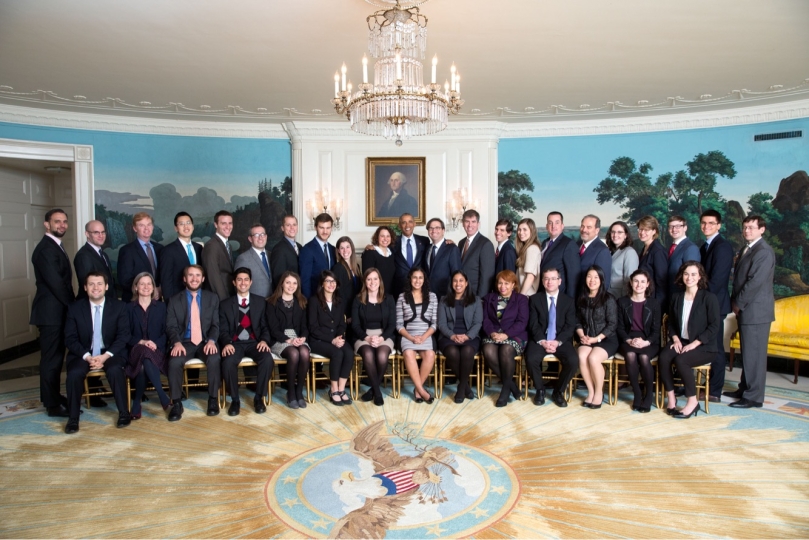For Neha Dalal, large-scale change in this country starts, but doesn’t end, with education.
“I’m a child of immigrants who came to the U.S. with virtually nothing,” said Dalal, A.B., S.M. ’16. “For my family, education was really the pathway to opportunity.”
But improving educational opportunities in underserved communities requires more than just fixing schools. Healthcare, wealth distribution, poverty, and criminal justice barriers often go hand-in-hand with education gaps and effectively addressing any one area will likely require addressing all of them.
Neha Dalal, A.B., S.M. ‘16. (Credit: Neha Dalal)
That will require a lot of funding and a clear strategy to distribute that funding. That’s where Dalal comes in. As a research economist at the White House Council of Economic Advisors for both Presidents Obama and Trump, she used her bachelor’s and master’s degrees in applied mathematics from the Harvard John A. Paulson School of Engineering and Applied Sciences (SEAS) to research and analyze the Department of Education’s College Scorecard, now part of the FAFSA federal student aid program.
Today, Dalal is Vice President of Philanthropic and Impact Advisory for Jasper Ridge, a California-based investment firm for high net worth individuals and other entities, where she advises clients on philanthropy and evaluates how to take environmental, social and governmental considerations into account while still finding the right products and services in which to invest.
“Harvard was where I realized I could combine my passion for numbers and data and economics, the very logical part of myself, with my desire to make the world a better place, the more emotional part of myself,” Dalal said. “These issues of education and opportunity are fundamentally very human issues, but I realized that numbers and data and economics can be incredibly powerful tools in helping us be more effective in our impact and make better decisions.”
Her applied mathematics and economics education taught her to use those tools to tackle some of today’s most pressing challenges.
“It really shaped how I think about the world in terms of trying to bring a very methodological approach to precisely defining a problem, trying to measure and quantify impacts, and trying to create a very clear, logical timeline for changing,” Dalal said. “And then beyond the broader framework of how to think, I’m very much still drawing on my understanding of economics, data science and statistics from a lot of the applied math and economic courses that I took.”
Dalal studied under Martin Feldstein, the late George F. Baker Professor of Economics at Harvard. Feldstein had previously chaired the Council of Economic Advisors under President Ronald Reagan, and at his encouragement, Dalal applied for an internship there as a junior in 2015.
Dalal said she definitely felt intimidated at times due to her youth. But being a college student gave her an invaluable perspective as she did research that would affect other people’s ability to go to college.
“I was working on FAFSA policy while I was filling out FAFSA myself,” she said. “I was working on things like student loan policy, when I was often one of the only people in the room that had actually gone through the modern-day student loan system.”
SEAS alumnus Neha Dalal with the White House Council of Economic Advisors in Washington, D.C. (Credit: Neha Dalal)
She returned to the CEA as a research and staff economist after graduating, continuing to work on policy for a variety of areas, including education, healthcare, employment and criminal justice. From there she went on to work for two non-profit policy advisory groups run by James Kvaal, an education advisor for President Obama and the current Under Secretary of Education for President Biden.
She also pursued an MBA from Stanford University, which helped broaden her understanding of how non-governmental funding could create change.
“There are three big pots of impact money in the world,” she said. “The government controls public funding. With non-profits, it’s philanthropy. And with for-profit funding, it’s impact investing. I realized that if I really want to drive large-scale change, if I really want to shove open the doors of opportunity, I need to understand all three of these pools of money.”
That approach eventually led her to Jasper Ridge in August.
“The big-picture question I’m trying to answer is how we can create a new system of wealth management that’s fundamentally aligned with impact,” Dalal said. “There’s so much to learn, and so much flexibility to learn from the private sector. And in terms of measuring impact more effectively, there are a lot of really interesting developments happening in impact investing and philanthropy around that.”
She wants to create change and use data science and statistics to show exactly how to accomplish that.
“Where the magic really happens is when you have a logical case that’s aligned with very emotional feelings and beliefs in the world,” Dalal said. “Then you see really dramatic progress.”
Press Contact
Matt Goisman | mgoisman@g.harvard.edu
